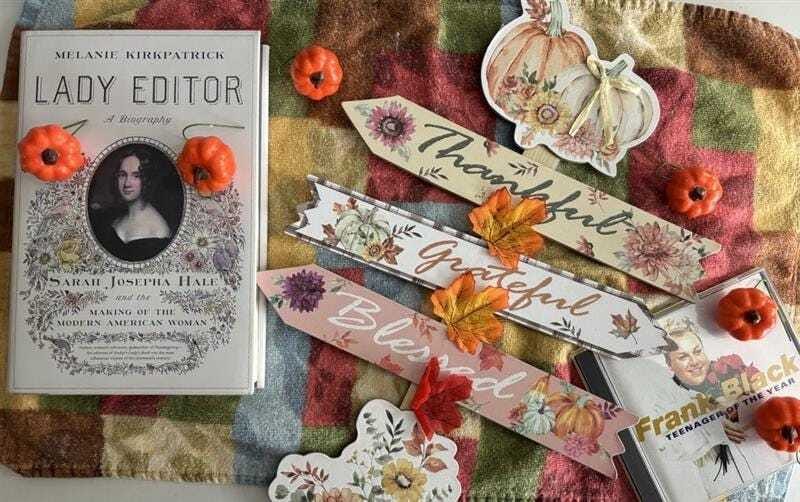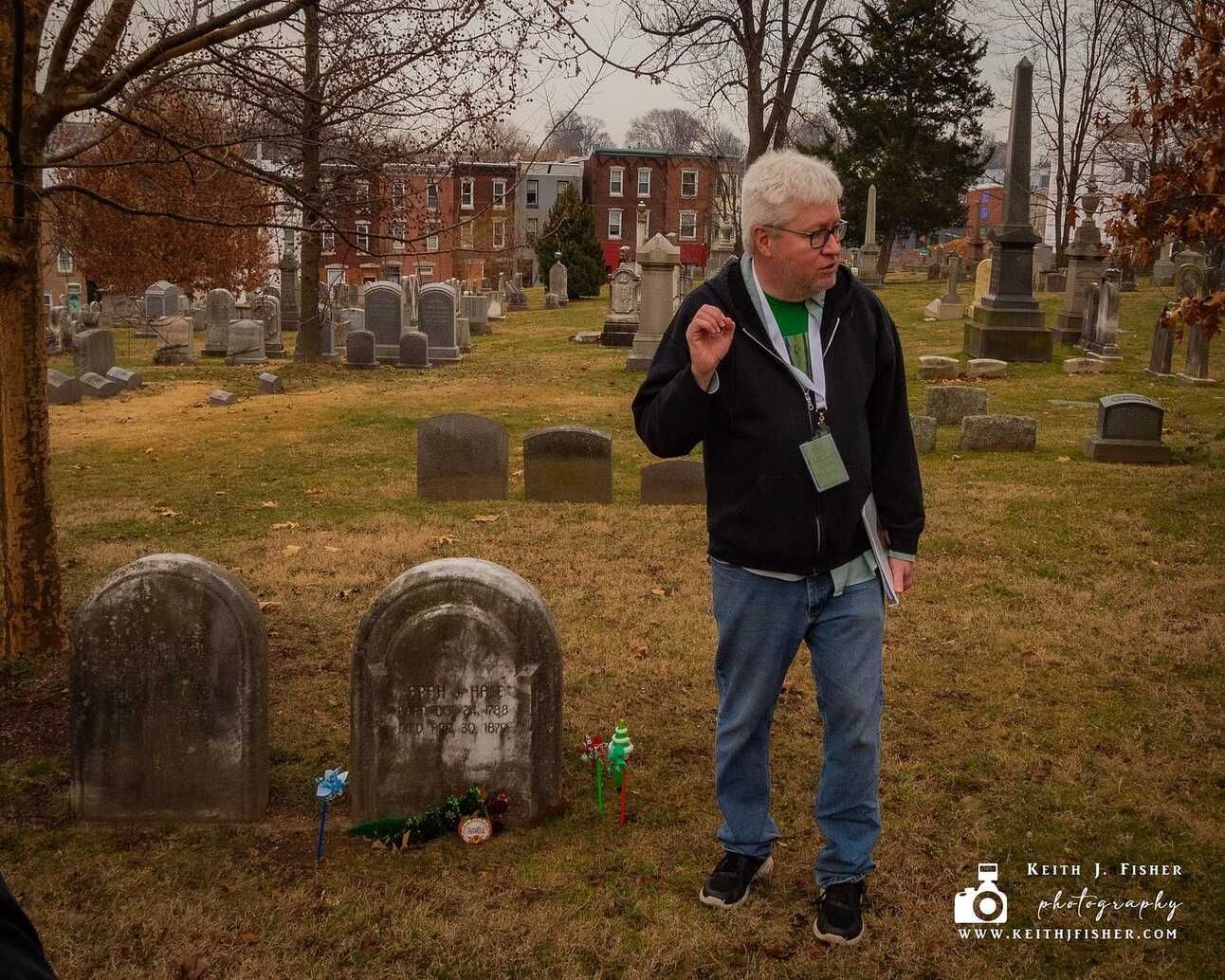- The Dichotomy of the Dog
- Posts
- Sarah J, Meet Frank Black
Sarah J, Meet Frank Black
This is the week when the Lady Editrix meets the Teenager of the Year.

I don’t have big memories of childhood Thanksgivings. I am sure we went through the motions but, for a variety of reasons, it was not a high priority holiday for us.
As I’ve moved through adulthood though, I have developed a gradual appreciation for Thanksgiving. I understand that people may have issues with the origins of the holiday, but I think the idea of spending time with loved ones and meditating a bit on gratitude can be a positive thing.
I also understand that results may vary.
One of the reasons that I have a new appreciation for Thanksgiving is that Sarah Josepha Hale, the influential “editrix” (Hale’s preferred title) of Godey’s Lady’s Book — the most popular American magazine for much of the 19th century — is buried at Laurel Hill Cemetery East, where I am a tour guide. Hale was a proponent of Thanksgiving and was largely responsible for Abraham Lincoln’s decision to make it a national holiday.
Early in her career, Hale wrote a book called Northwood, published in 1827. The novel includes a description of a traditional New England Thanksgiving that records many aspects of the holiday that modern readers would still recognize. I will include that excerpt at the end of this post.
So, how did Frank Black, aka Pixies singer/guitarist/songwriter Black Francis, enter the fray? It’s like this: some time, maybe between 15 and 20 years ago, it was Thanksgiving Day and I was decrying the ridiculous nature of Black Friday shopping, which was at its excessive peak. I boldly proclaimed that I was not going to leave my house on Black Friday, and that I’d sit around listening to Frank Black CDs instead. At that point, apparently Donna said:
“Oh, you mean like Frank Black Friday?”
And thus, Frank Black Friday was born. A day set aside to appreciate the solo work of Frank Black.
My advice to anyone who wants to observe Frank Black Friday is simply to listen to the man’s work. Start with the first two solo albums, his self-titled debut and the thoroughly brilliant Teenager of the Year, which is probably my favorite album of the 1990s. Both of those albums can be listened to and enjoyed, beginning-to-end.
The rest of Frank Black’s solo library is fun to explore as well, ranging from noisy rock’n’roll to rootsy Americana. His entire body of solo work beyond those first two albums is a lot to take in during the course of one day, so I’d suggest you just jump in and sample tunes from various albums, some of which you’ll find under Frank Black and others under “Frank Black and the Catholics.”
And now, here’s a photo of me at Sarah J. Hale’s grave, followed by her Thanksgiving description from Northwood.

From Northwood (1827) by Sarah Josepha Hale
(pp. 114-117, Google Book edition)
But now to dinner, or supper – perhaps the former would be the more appropriate name, but the latter is the most ancient and most used in the country, therefore I have retained it. A long table, formed by placing two of the ordinary size together, was set forth in the parlor, which being the best room, and ornamented with the best furniture, was seldom used, except on important occasions. The finishing of the parlor was in a much better manner than that of any other apartment in the house; the wood work was painted cream color, and the plaster walls ornamented with paper hangings of gay tints and curious devices.
Over the mantelpiece hung two paintings, executed by Sophia and Lucy, representing scenes from the Shepheresss of the Alps. A connoisseur in the art would undoubtedly have seen faults in both pieces, on which he might have displayed his critical acumen to advantage. He might have objected that the shepherd was nearly black and the shepherdess was very blue – her nose and not her stockings – that the sheep resembled wolves, and the rocks coffins; but such profane things never had been said of them, for they had been examined only by those who, having the landscape of nature always before their eyes, require both strange and new in an exhibition of art. They had therefore not only escaped all censure, but even excited rapturous praise.
The furniture of the parlor consisted of a mahogany sideboard and table, a dozen handsome rush-bottomed chairs, a large mirror, the gilt frame covered with green gauze to prevent injury from dust and flies, and on the floor was a substantial, home manufactured carpet, woven in a curious manner and blended with all the colors of the rainbow. Seldom were the junior members of the family allowed the high privilege of stepping on the carpet, excepting at the annual festival, and their joy at the approaching feast, was considerably heightened by the knowledge that it would be holden in the best room.
The table, covered with damask cloth, vieing in whiteness, and nearly equally in texture, the finest imported, though spun, woven and bleached by Mrs. Romless’ own hand, was now intended for the whole household, every child having a seat on this occasion, and the more the better, it being considered an honor for a man to sit down to his Thanksgiving supper surrounded by a large family. The provision is always sufficient for a multitude, every farmer int eh country being, at this season of the year, plentifully supplied, and every one proud of displaying his abundance and prosperity.
The roasted turkey took precedence on this occasion, being placed at the head of the table; and well did it become its lordly station, sending forth the rich odour of its savoury stuffing, and finely covered with the frost of the basting. At the foot of the board a sirloin of beef, flanked on either side by a leg of pork and joint of mutton, seemed placed as a bastion to defend innumerable bowls of gravy and plates of vegetables disposed in that quarter.
A goose and pair of ducklings occupied side stations on the table, the middle being graced, as it always is on such occasions by that rich burgomaster of the provisions, called a chicken pie. This pie, which is wholly formed of the choicest parts of fowls, enriched and seasoned with a profusion of butter and pepper, and covered with an excellent puff paste, is, like the celebrated pumpkin pie, an indispensable part of a good and true Yankee Thanksgiving; the size of the pie usually denoting the gratitude of the party who prepares the feast. The one now displayed could never have had many peers. Frankford had seen nothing like it, and recollected nothing in description bearing a comparison, excepting the famous pie serve up to the witty King Charles II, and containing, instead of the savory chicken, the simple knight.
Plates of pickles, preserves, and butter, and all the necessaries for increasing the seasonings of the viands to the demand of each palate, filled the interstices on the table, leaving hardly sufficient room for the plates of the company, a wine glass and two tumblers for each, with a slice of wheat bread lying on one of the inverted tumblers.
A side table was literally loaded with the preparations for the second course, place there to obviate the necessity of leaving the apartment during the repast. Mr. Romlee, keeping no domestic, the family were to wait on themselves, or on each other.
There was a huge plumb pudding, custards, and pies of every name and description ever known in Yankee land; yet the pumpkin pie occupied the most distinguished niche.
There were also several kinds of rich cake, and a variety of sweet meats and fruits. On the sideboard was ranged a goodly number of decanters and bottles; the former filled with currant wine and the latter with excellent cider and ginger beer, a beverage Mrs. Romlee prided herself on preparing to perfection. There were no foreign wines or ardent spirits, Squire Romlee being a consistent moralist.